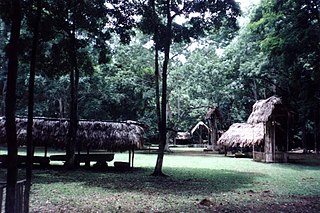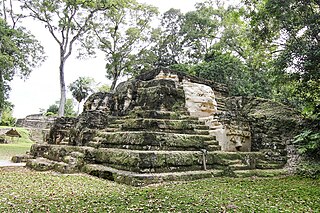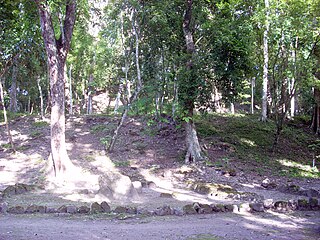Related Research Articles


Tikal is the ruin of an ancient city, which was likely to have been called Yax Mutal, found in a rainforest in Guatemala. It is one of the largest archeological sites and urban centers of the pre-Columbian Maya civilization. It is located in the archeological region of the Petén Basin in what is now northern Guatemala. Situated in the department of El Petén, the site is part of Guatemala's Tikal National Park and in 1979 it was declared a UNESCO World Heritage Site.

Uaxactun is an ancient sacred place of the Maya civilization, located in the Petén Basin region of the Maya lowlands, in the present-day department of Petén, Guatemala. The site lies some 12 miles (19 km) north of the major center of Tikal. The name is sometimes spelled as Waxaktun.

Tonina is a pre-Columbian archaeological site and ruined city of the Maya civilization located in what is now the Mexican state of Chiapas, some 13 km (8.1 mi) east of the town of Ocosingo.
Yohl Ikʼnal, also known as Lady Kan Ik and Lady Kʼanal Ikʼnal, was queen regnant of the Maya city-state of Palenque. She acceded to the throne on 23 December 583, and ruled until her death.

Tazumal is a pre-Columbian archeological site in Chalchuapa, El Salvador. Tazumal is an architectural complex within the larger area of the ancient Mesoamerican city of Chalchuapa, in western El Salvador. The Tazumal group is located in the southern portion of the Chalchuapa archaeological zone. Archaeologist Stanley Boggs excavated and restored the Tazumal complex during the 1940s and 1950s.

Tat'yana Avenirovna Proskuriakova was a Russian-American Mayanist scholar and archaeologist who contributed significantly to the deciphering of Maya hieroglyphs, the writing system of the pre-Columbian Maya civilization of Mesoamerica.

Ixlu is a small Maya archaeological site that dates to the Classic and Postclassic Periods. It is located on the isthmus between the Petén Itzá and Salpetén lakes, in the northern Petén Department of Guatemala. The site was an important port with access to Lake Petén Itzá via the Ixlu River. The site has been identified as Saklamakhal, also spelt Saclemacal, a capital of the Kowoj Maya.

Río Azul is an archaeological site of the Pre-Columbian Maya civilization. It is the most important site in the Río Azul National Park in the Petén Department of northern Guatemala, close to the borders of Mexico and Belize. Río Azul is situated to the southeast of the Azul river and its apogee dates to the Early Classic period.

Kinal is a major pre-Columbian Maya archaeological site in the Petén Department of the modern-day Petén Department of northern Guatemala. The major occupational phase for the site dates from the Late Classic period of Mesoamerican chronology, with evidence for a substantial and expansionary building program dating from the first half of the 8th century AD. Kinal was discovered in the 1960s by archaeologist Ian Graham while he was carrying out an archaeological survey of the region, although no excavations were undertaken at the site at that time.
Altar de Sacrificios is a ceremonial center and archaeological site of the pre-Columbian Maya civilization, situated near the confluence of the Pasión and Salinas Rivers, in the present-day department of Petén, Guatemala. Along with Seibal and Dos Pilas, Altar de Sacrificios is one of the better-known and most intensively-excavated sites in the region, although the site itself does not seem to have been a major political force in the Late Classic period.
"Fish-Fin" is a designation or nickname given by Mayanist epigraphers to a personage whose undeciphered name-glyph appears in the epigraphic record in association with the Emblem glyph of Bonampak, a pre-Columbian Maya civilization site in present-day Chiapas, Mexico.
Ross Hassig is an American historical anthropologist specializing in Mesoamerican studies, particularly the Aztec culture. His focus is often on the description of practical infrastructure in Mesoamerican societies. He is the author of several influential books, among them: Time, History, and Belief in Aztec and Colonial Mexico; Aztec Warfare: Imperial Expansion and Political Control; and Trade, Tribute, and Transportation: The Sixteenth-Century Political Economy of the Valley of Mexico.
Eduard Georg Seler was a prominent German anthropologist, ethnohistorian, linguist, epigrapher, academic and Americanist scholar, who made extensive contributions in these fields towards the study of pre-Columbian era cultures in the Americas.

The Maya civilization was a Mesoamerican civilization that existed from antiquity to the early modern period. It is known by its ancient temples and glyphs (script). The Maya script is the most sophisticated and highly developed writing system in the pre-Columbian Americas. The civilization is also noted for its art, architecture, mathematics, calendar, and astronomical system.
David C. Grove was an American anthropologist, archaeologist and academic, known for his contributions and research into the Preclassic period cultures of Mesoamerica, in particular those of the Mexican altiplano and Gulf Coast regions. A lecturer and professor at University of Illinois at Urbana-Champaign (UIUC) for some thirty years, Grove retained a position as Professor Emeritus of Anthropology at UIUC and was also designated a Courtesy Professor of Anthropology at the University of Florida.

Cuello is a Maya archaeological site in northern Belize. The site is that of a farming village with a long occupational history. It was originally dated to 2000 BC, but these dates have now been corrected and updated to around 1200 BC. Its inhabitants lived in pole-and-thatch houses that were built on top of low plaster-coated platforms. The site contains residential groups clustered around central patios. It also features the remains of a steam bath dating to approximately 900 BC, making it the oldest steam bath found to date in the Maya lowlands. Human burials have been associated with the residential structures; the oldest have no surviving burial relics, but from 900 BC onwards, they were accompanied by offerings of ceramic vessels.

Tikal Temple II is a Mesoamerican pyramid at the Maya archaeological site of Tikal in the Petén Department of northern Guatemala. The temple was built in the Late Classic Period in a style reminiscent of the Early Classic. Temple II is located on the west side of the Great Plaza, opposite Temple I. Temple II was built by the king Jasaw Chan K'awiil I in honour of his wife, Lady Kalajuun Une' Mo'. Temple II had a single wooden sculpted lintel that bears the portrait of a royal woman who may have been the wife of Jasaw Chan K'awiil I, who was entombed beneath Temple I. Lady Kalajuun Une' Mo', whose name means "Twelve Macaw Tails", was also important for being the mother of Jasaw Chan K'awill I's heir. In fact her son Yik'in Chan K'awiil oversaw the completion of Temple II when he became king.

Tikal Temple VI is a Mesoamerican pyramid in the ruins of the major Maya city of Tikal, in the Petén department of northern Guatemala. Temple VI is located at the southeastern end of the Mendez Causeway, which links the temple plaza with the site core. The temple faces west onto a walled plaza. The existence of the temple was first reported in 1951 by Antonio Ortiz on behalf of the Instituto de Antropología e Historia. The roof comb of the temple is inscribed on its sides and back with a lengthy hieroglyphic text. The pyramid's summit superstructure contains two chambers, and the highest surviving portion of the temple's roof comb stands 12 metres (40 ft) high. The pyramid superstructure is accessed via three west-facing doorways. The triple doorway and interior layout of the chambers suggest that Temple VI was in fact a palace-type structure rather than a temple.

The North Acropolis of the ancient Maya city of Tikal in Guatemala is an architectural complex that served as a royal necropolis and was a centre for funerary activity for over 1300 years. The acropolis is located near the centre of the city and is one of the most studied of Maya architectural complexes. Excavations were carried out from 1957 to 1969 by the University of Pennsylvania, directed by Edwin M. Shook and William Coe.
References
- Adams, Richard E.W. (1991). Prehistoric Mesoamerica (Revised ed.). Norman: University of Oklahoma Press. ISBN 0-8061-2304-4. OCLC 22593466.
- Adams, Richard E.W. (1999). Río Azul: An Ancient Maya City. Norman: University of Oklahoma Press. ISBN 0-8061-3076-8. OCLC 39951697.
- Culbert, T. Patrick (1991). "Polities in the northeast Peten, Guatemala". In T. Patrick Culbert (ed.). Classic Maya Political History: Hieroglyphic and Archaeological Evidence. School of American Research advanced seminar series. Cambridge: Cambridge University Press. pp. 128–146. ISBN 0-521-39210-1. OCLC 20931118.
- Sharer, Robert J.; Loa P. Traxler (2006). The Ancient Maya (6th edition (fully revised) ed.). Stanford, CA: Stanford University Press. ISBN 0-8047-4816-0. OCLC 28067148.